On May 14, 2015 I whisked through immigration and customs at the John Bird International Airport in St. John’s, Antigua for the second time in three years.
Business as an expert witness in a trial concerning construction defects in the home of the Brazilian Ambassador drew me to this island that’s part of the Lesser Antilles in the Caribbean Sea.
I was to spend a week on this tropical island with lots of time to get on the air with my QRP radio, the trusty HB-1B.
Never before had I had the real chance to operate relaxed on the air for hours. It was my chance to hone my beginner skills at CW. It was to be my first time operating next to a giant puddle of salt water which helps radio signals. Believe me, I’d need help!
I was filled with excitement about what might happen in the next seven days, the trial notwithstanding!
The WX
I live in New Hampshire and the winter of 2014-2015 was bitter cold. Spring came late to the great Northeast Kingdom. The morning I flew out of JFK airport, the air temperature in New York City was below 50 F.
Suffice it to say that the hot and humid weather in Antigua was a shock to my system.
Being so close to the equator, the sun’s infrared and ultraviolet rays are intense from 10 a.m. until 4:00 p.m. It was hard to be in the sun in the middle of the day without great discomfort. On the third day there I got sunburned and my new name was Lobster Man.
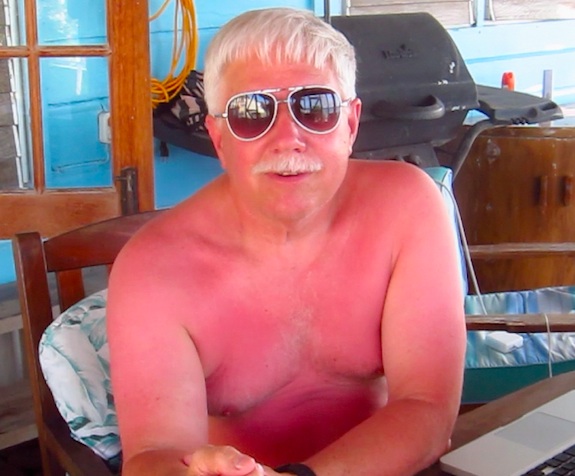
Need I say more? Wait TEN MINUTES before jumping in pool.
My QTH
I stayed in an older small two-bedroom house that’s just 30 feet from the sea. The owners call this quaint and romantic hut the Love Shack as they have guests stay in it frequently.
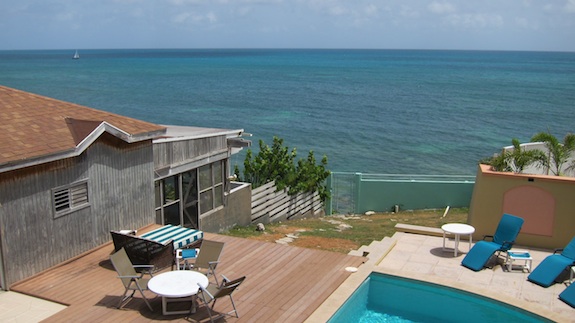
This is the Love Shack as it’s called by the owners.
It had a glorious screened-in porch that faces the deep blue and turquoise water, but there was no nearby tree at this end of the abode to put up an antenna.
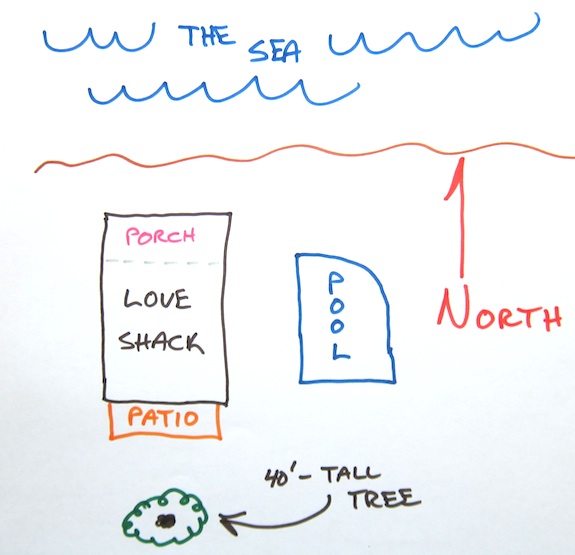
This is a simple map of the shack in relation to the sea and the tree.
As a result, I operated most of the time on a patio at the other end of the shack.

Most of my contacts happened sitting on this bench. One day a lizard tried to take a bite out of one of my toes here. Bad lizard.
Right next to the patio was a wondrous tree that accepted my micro-cord halyard with no complaints. Once the cord is up in the tree, it’s not an issue to haul up the antenna.

The tree did its job.
Five of the nights I stayed there, I slept on a couch on the porch. It was glorious listening to the waves crash on the rocks.
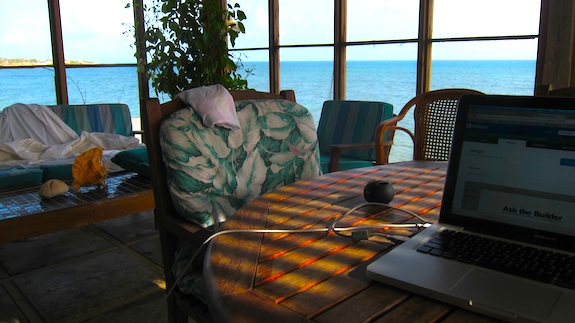
This is inside the screened porch looking out. You can see there on the left my unmade bed. Life is hard in Antigua.
As you might imagine, it’s pitch black at night down there. The humid air makes it difficult to see lots of stars, but in the middle of the night on May 18th, I saw a brilliant shooting star. It was so vivid and the light so bright I was in awe. It streaked across Boone’s Bay and was the brightest shooting star I’ve ever seen.
I don’t know why I was awake to see it, but I felt it was a sign that my radio fortunes would increase the remainder of the trip.

This is the shore just below the screened porch. I can still hear the gentle waves washing up on the limestone. The tide level each 6 hours rose or fell only about 30 inches is my guess.
Antennas
I brought with me my tested and reliable par EndFedz 10, 20 and 40-meter antenna. It was the workhorse most of the days. This is a marvelous antenna for outdoor radio. The wire is as thin as an uncooked piece of angel-hair spaghetti.
All of my gear that I needed to operate fit into a water-resistant plastic box that’s only 3.5 inches tall, 7 inches wide and 6 inches deep. Isn’t that amazing?
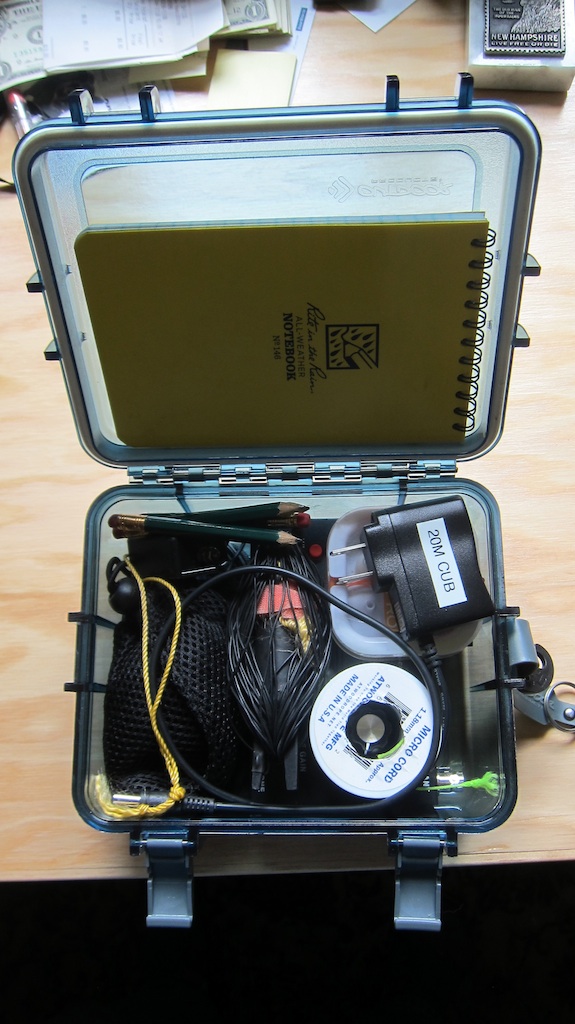
Everything is in this box. The HB-1B is buried down under everything else. The only thing I need to operate is a rock to help get the green micro cord halyard up into a tree. A partially filled water bottle is my weapon of choice.
Less than two weeks before arriving, I also made a resonant center-fed 30-M dipole antenna as the HB-1B is set up for that band.
The first day there I set up my par EndFedz antenna as a sloper in the giant tree. It sloped to the north and it appears that was my best setup during the trip.
On the second day I threw the halyard higher in the tree and achieved a nearly vertical set up with the par. I was able to make contacts, but not as many as with it as a sloper. Propagation could have also been an issue.
On the last day I finally set up my resonant 30-M dipole and it worked quite well. It was a gentle sloper starting high up in the great tree and the other end was close to the screened-in porch. It also sloped to the north.
My License
To operate legally in Antigua, you need to obtain a license from the government. You can read all about that process and how I got my Antiguan call sign V25TB.
The Bands
What’s the old saying? Timing is everything.
The band conditions during the period of May 14 – 20, 2015 were not the best. Add to that the difficulty of operating at a power level of 5 watts or less. Yes, CW can travel quite far with minimal power, but it really helps if propagation is favorable.
I was able to complete a QSO with UT5URW – Andrei in Kiev, Ukraine, so I was thrilled with that. He got the long-distance award!
My outdoor QRP and CW mentor Jim Cluett – W1PID was able to work me several times. I was very excited that I was able to hear him and him me. He’s been eternally patient with my slow and steady, but sometimes backwards, progress in HF and CW. Jim is one of the giants in outdoor radio and has established quite a reputation in the QRP community.
A new friend, Dave Benson – K1SWL who lives in New Hampshire and is an expert at low-power operation, was in my log two times. What a delight that was to work one of the icons of QRP radio!
What I Learned
My biggest takeaway from the experience was it pays to have a longer coaxial cable from the antenna to where you think the best place is to operate. Just before the trip I purchased a 25-foot RG-174 cable. It was fantastic, but a 50-foot one would have had me operating on the screened porch. However, that long cable may have introduced too much loss with my QRP setup.
There are always compromises.
I also came away knowing that I truly love doing CW and am more determined than ever to get better and better. There’s something magical to me about CW. It’s such a basic language when you think about it, but it confounds many.
My attraction to CW is you have to work your brain to understand what you’re hearing and you get to use your hands on the micro Palm Pico paddles to send the dihs and dahs thousands of miles through the ether. As Jim often says, “It’s magic.”
Yes it is. Powerful magic for the soul.
I was also happy for all I was able to work so they would have Antigua as another foreign country in their log books. Antigua is a small country and it’s a third-world country. There can’t be but a handful of amateur operators on the island.
My Log
Here are the four pages of contacts I made while in Antigua. It’s a week I’ll never forget, that’s for sure!


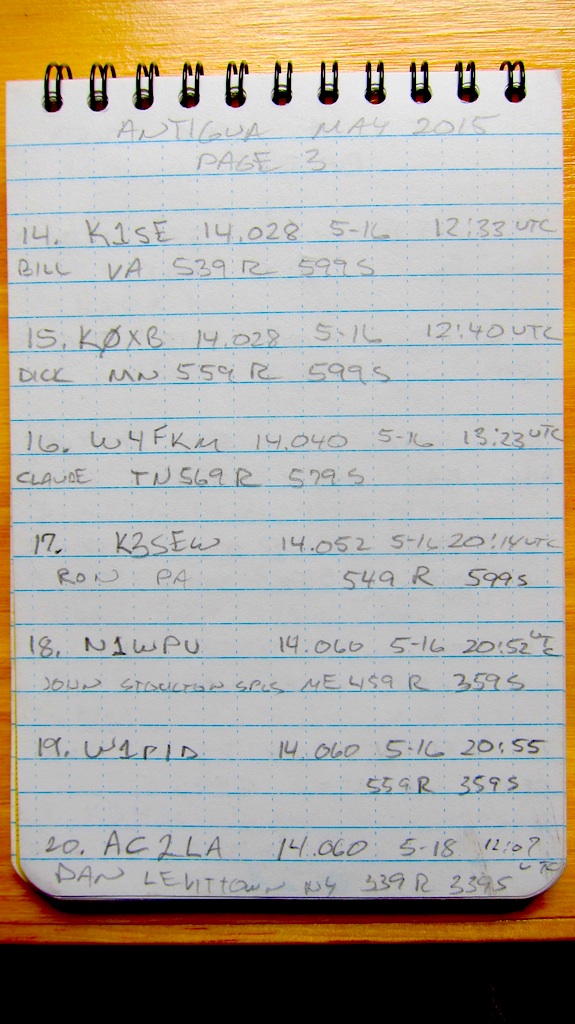
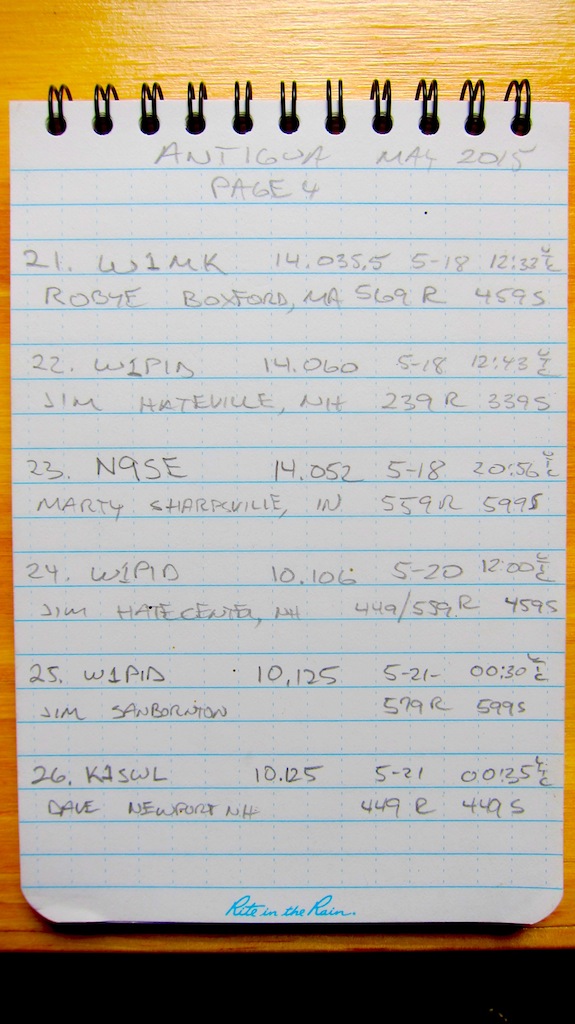

Pingback: Livermore Falls Campton, NH QRP Adventure | W3ATB